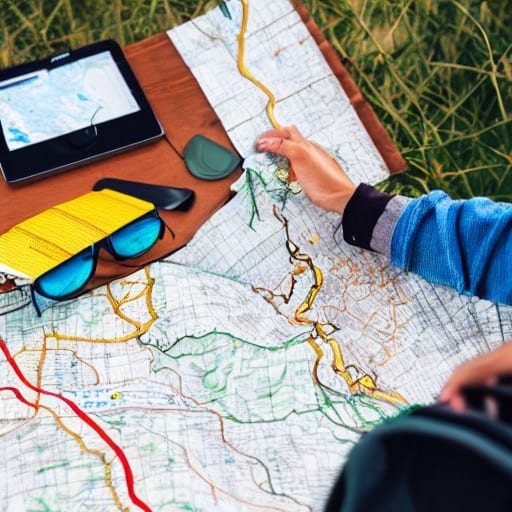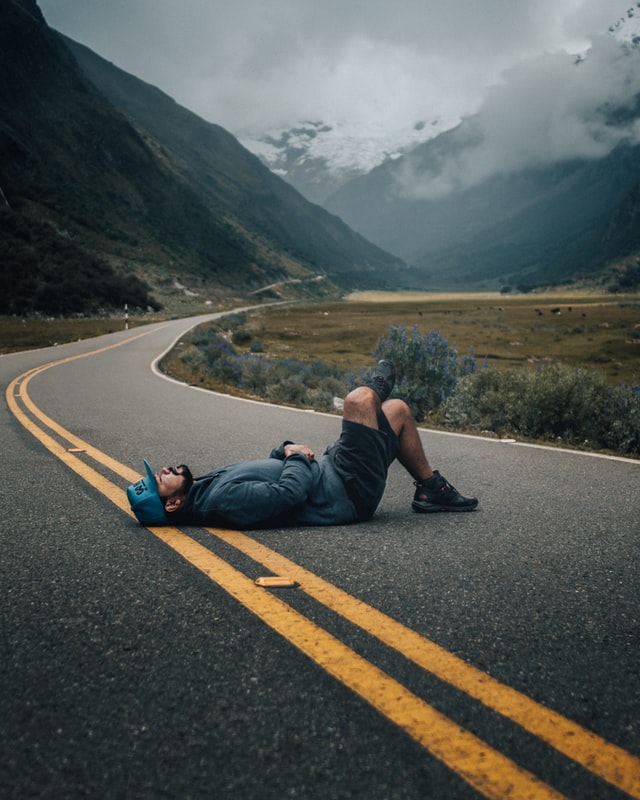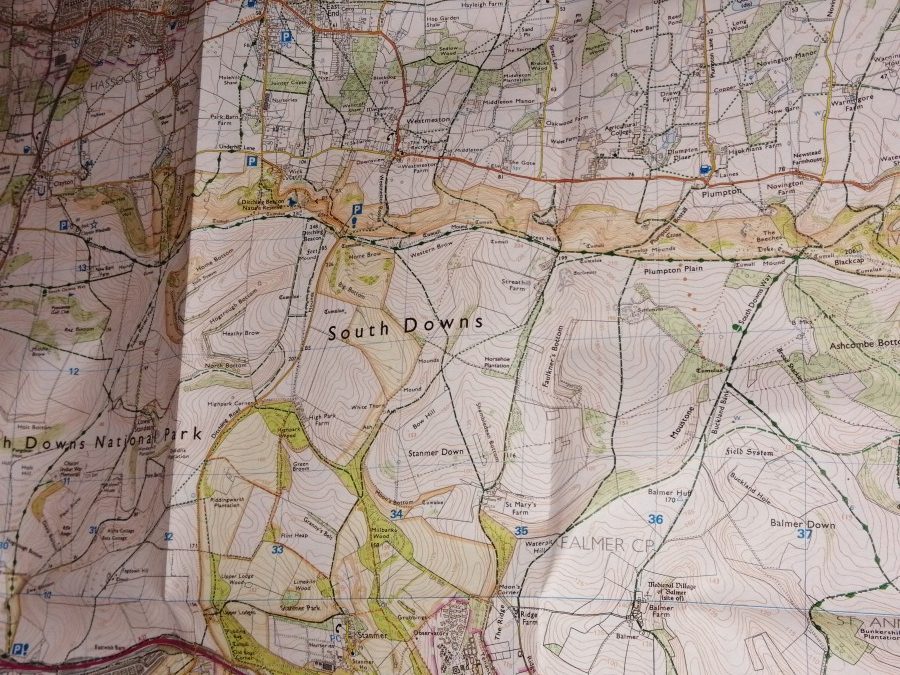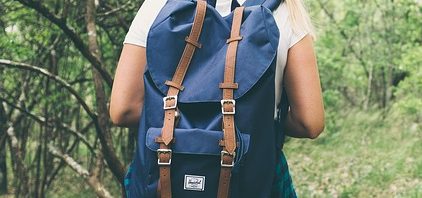Table of Contents
Some links on posts are affiliate links and will earn us a commission from qualifying purchases
Whilst it’s great to walk with others, at times it’s not always possible, and some people even prefer to walk alone. However, it’s important to be aware that walking with others can be safer. So here are 15 safety tips for when you hike alone.
Preparation: Safety Tips For Hiking Alone Before You Set Off
Staying safe can be easy if you prepare well at any time, but especially if you are planning to hike alone.
1 – Choosing your route
When choosing a route for a solo walk, safety should be of utmost importance. It’s best to avoid remote and unfamiliar paths. Instead, opt for a well-known or popular route with plenty of other people around. Alternatively, choose a familiar path that you’ve walked multiple times before. This way, you’ll be better prepared and less likely to encounter unexpected obstacles. Remember, it’s always better to be safe than sorry when it comes to exploring the great outdoors!

2 – Avoid dangerous features
Staying safe should always be a top priority, especially when enjoying the great outdoors. Take precautions against natural hazards such as slippery river crossings or steep mountain paths. Even if you are an experienced adventurer, it’s always best to hike with a friend or group of trustworthy individuals. They can provide assistance or alert emergency services if needed – giving you the peace of mind to enjoy your exhilarating walks to the fullest!
3 – Tell someone where you are going
If you plan on heading out alone for your next adventure, it’s essential to take the necessary precautions to ensure your safety. While getting lost might be the last thing you expect to happen, it’s always a possibility. If you’re not familiar with the route, or you underestimate the time it’ll take to get to your destination, you could quickly find yourself in danger.
That’s why it’s important to inform someone of your whereabouts before taking off. By letting your best friend or partner know about your route and an approximate time of arrival, you’ll have someone looking after you from afar. In case you don’t reach your destination within the expected timeframe, they can attempt to contact you to ensure you’re not in danger. If they don’t get a reply, then they know there’s a chance that you might be in trouble, and can alert the authorities if necessary. So before you embark on your next adventure, remember to prioritize your safety by informing someone of your plans.
4 – Know your limits
Although’s true that you may be able to exceed your usual walking limits when out for a hike, it’s important to be cautious and keep within your boundaries. Straying too far from home or hiking at an unusually fast pace can result in painful muscle injuries.
Additionally, if you attempt to climb steep hills that are unfamiliar to you, you may find it more challenging than expected. So, it’s always better to stick to familiar trails and to save those adventurous hikes for when you have a companion by your side. Remember, it’s better to stay safe and fully enjoy your time in nature.

5 – Ensure you have essential resources
If you are going to be hiking alone for more than a few hours, you will need to ensure that you have food with you, unless you plan to stop in a village or town. So make sure you take a little extra, just in case you do get stuck somehow and need to keep yourself nourished. And that goes for water too – don’t run out and get dehydrated way before you finish.
What happens if you get lost and get cold as the evening draws in? Make sure you have a lightweight mid-layer and/or waterproof jacket. And if there is a chance of it getting dark, ensure you have packed a head torch to help show the way.
6 – Weather
Before you set off, check the weather forecast for the rest of the day. You may not realise that storms are due in the latter part of the day – have you got waterproofs? You certainly don’t want to get caught in a thunderstorm. Or maybe you are wrapped up as it’s cold when you set out, but the sun is due to come out in an hour and the temperature due to rise significantly. Have you got a sun hat and sun block, as well as enough water?
7 – Your route
Planning a route can take weeks, and you may think you have everything figured out. But even with such meticulous preparation, it’s always wise to bring along a map or guidebook. This way, you can easily refer to it regularly during your journey to ensure you’re en route. This is especially crucial if you’re taking a route that’s new to you and that you haven’t had the chance to memorize yet.
As a matter of fact, my friend Nicky and I almost always take a wrong turn the first time we embark on a new adventure. So, having a map or guidebook gives us the confidence we need to forge ahead with our journey and see everything we set out to see.

8 – Your first solo hike
If you are planning your first solo hike, taking it easy is key. It’s important not to overestimate your own capabilities. Rather start small, perhaps embarking on just a couple of miles on a route that you’ve done before, instead of planning an epic journey. By starting small, you will be able to gain confidence and prepare yourself for more ambitious hikes in the future.
It’s also helpful to consider taking an easy out and back route, as opposed to a circular one. The latter can be more challenging and can make it easier to get lost, especially if you are new to the area. With an out and back route, you have a clear path to follow, which can help to reduce the chance of getting lost. Remember, the key to a successful solo hike is to set yourself up for a safe and enjoyable experience.
Safety whilst hiking alone: Tips for you to remember whilst walking
9 – Meeting other hikers
While most people you meet while hiking are friendly and safe, it’s important to trust your instincts when it comes to your personal safety. If you encounter someone on the trail who makes you feel uncomfortable, try to get away from them as quickly and safely as possible. If there’s no immediate escape route, consider latching onto other groups of hikers for added safety. Remember, there’s safety in numbers! Always prioritize your own well-being and listen to your gut instincts.
10 – Check your map
During your preparation before going out, we mentioned the significance of checking the map or guidebook that you brought with you. Merely carrying it might not be enough as there could be an issue with the content, which could give you wrong directions.
Therefore, it’s always better to ensure accuracy by verifying the information on your guidebook or map. By doing this, you can realise if you’ve gone off-route earlier rather than later, allowing you to correct and proceed in the right direction or to return to the point you went off-track. So, always double-check your map or guidebook to avoid unnecessary confusion or headaches.
11 – Don’t be scared to admit defeat
If you find yourself in a situation where you’ve either gone way off track or you’re feeling unsafe while walking, it’s important to prioritize your safety above all else. While it may be tempting to push on and try to complete your walk, sometimes it’s better to take a step back and retrace your steps instead.
Remember that it’s important to always be prepared when venturing outdoors, and sometimes that means calling it a day and trying again in the future with a friend or more suitable equipment. Be sure to keep these safety tips in mind on your next adventure!
12 – Local wildlife
While not as much of an issue in the UK compared to the wilds of Africa or America, it is still important to be mindful of the local wildlife. While you may not encounter alligators or bears in the UK, it is possible to come across a field of cows or deer which can be a startling experience. It can be useful to take some time to look up before moving from field to field to see if there are any wildlife present that you should be cautious of.
For individuals with fears such as cows, it’s best to steer clear rather than find yourself in the midst of a herd before it’s too late to turn around. Being aware of the local wildlife and taking appropriate precautions can make for a safer and more enjoyable time engaging with nature.

13 – Avoid using headphones
As much as headphones can be great for keeping you motivated and entertained during a hike, when you are alone in the wilderness, you need to be alert and aware of your surroundings. Being able to hear the sounds of rustling leaves, twigs snapping, and critters scurrying could alert you to the presence of potential danger or simply immerse yourself in the natural beauty of your surroundings. So if you want to be fully present and safe in the wild, it’s best to ditch the headphones and embrace the sounds of nature.
14 – Asking for help
During your hiking adventure, you may encounter a few unexpected obstacles. It’s possible that you’ll get lost, have issues with blisters, or even run out of water. In such scenarios, don’t be afraid to ask other hikers for help. They have most likely faced similar issues themselves, and would be happy to guide you back on track, offer you plasters, or provide you with water to refill your bottle. Embrace the camaraderie and helpfulness of fellow hikers on the trail; you may end up forming new friendships along the way!
15 – Checking in with others
It’s always a good idea to inform a friend or partner where you’re headed. Not only does it give them peace of mind, but it could also be helpful to you in case of an emergency.
To take it one step further, consider checking in with them periodically throughout your journey. A quick phone call to mention the landmarks you’ve reached could be incredibly valuable if you run into trouble later on. That way, they’ll know the exact route you took and can look for you starting from the last landmark you shared.
It’s a simple precaution that could make a big difference in case of an emergency.
Conclusion – 15 Safety Tips For Hiking Alone
Although walking and hiking alone can be enriching experiences, they also come with certain risks. However, by taking the necessary safety precautions, you can make sure that your solo hikes remain safe and enjoyable. Here are 15 essential tips that will provide you with the confidence to go hiking alone and fully savour the beauty of the walk without any safety concerns, and return home fully satiated, recharged and ready for your next adventure.
Read More
How do you keep warm at the start of walks? The Layering System
How do you keep warm at the start of walks? This is one of the most common questions asked by people new to hiking as they hit their first winter. They probably started hiking in spring or summer,...
Is it weird to go hiking alone? Benefits for and reasons not to
Sometimes it's not always possible to go walking with others, on occasions you may need to hike alone. Or maybe that's what you would actually prefer, setting out alone and getting away from...


